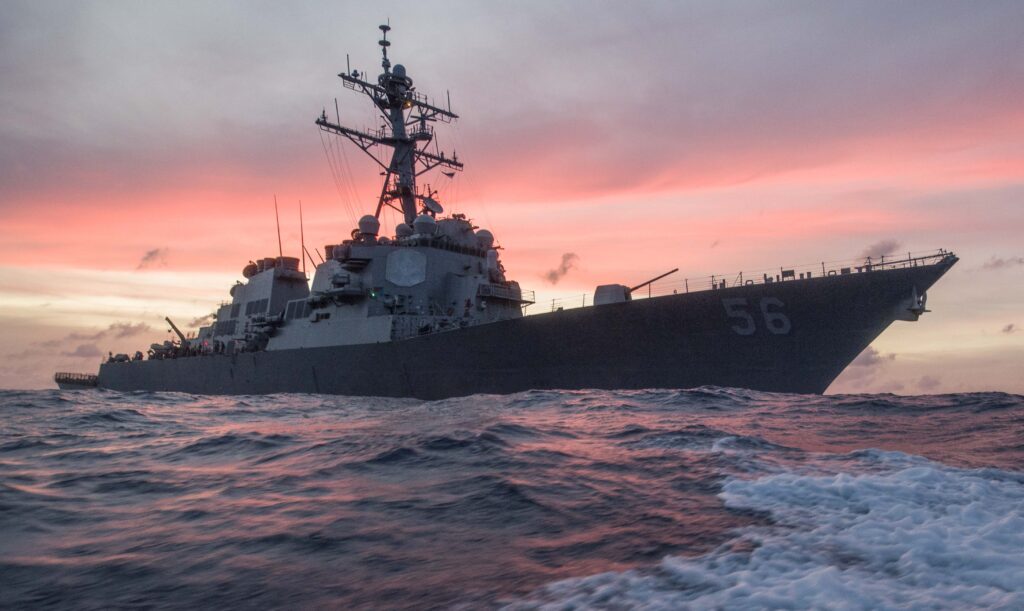Carrier Ford Sails This Week; Future Destroyer Proposals In 2020
Posted on

The future USS Ford is christened at Newport News shipyard.
NATIONAL HARBOR: The long-delayed supercarrier Gerald Ford should set sail for builders’ trials this week, the head of Naval Sea Systems Command said today. If those builders’ trials and subsequent Navy acceptance trials go well, Vice Adm. Thomas Moore told reporters at the Sea-Air-Space conference here, “I think we’ll get the ship delivered in the April-May timeframe and then we can move on with commissioning.”

Vice Adm. Thomas Moore
As America’s first all-new carrier design since the Nimitz in 1976, the Ford class will serve into at least into the 2070s. But many of their escorts will be late-model Arleigh Burke-class destroyers, so-called “Flight III” updates of a 1980s design whose first ship, DDG-51, was commissioned in 1991. That’s why the Navy is brainstorming a next generation Future Surface Combatant, aiming to solicit design proposals from industry around 2020.
“DDG’s a great class of ship… but we’re never going to build Flight IV, we need to move on,” Moore said. “It’s probably time for us to work from a clean sheet.”
Moore is on a steering committee for the clean-sheet Future Surface Combatant, along with three-star counterparts from the Navy staff (OPNAV) and the operational fleet. The idea is to have warfighters, shipbuilders, and budgeteers working together from the start, instead of one group coming up with unrealistic requirements for a super-ship the others can’t build or can’t afford.
Below the 3-star panel, Moore said, “there’ll be a working level group at the one or two-star level that will come back and present us with concepts and a plan of action, and we’ll go back to the CNO (the Chief of Naval Operations, Adm. John Richardson). I’d expect we would formally kick this off at the DoD 5000 (regulation) level — where we have a charter and we start working on an AOA (Analysis of Alternatives) — probably at the end of this summer.”

The USS McCain (DDG 56), named after the senator’s father and grandfather, both admirals.
“We’re looking at how do you move this process faster so we can get to the point where we’re ready to issue an RFP (Request For Proposals) out to start working on a design for the ship,” Moore said. “Typically, that’d take us four to five years,” i.e. until about 2022, but his “aspirational plan” is to release the RFP for designs “about 2020.”
What should the Future Surface Combatant look like? That’s what all these studies are supposed to figure out, but a few basics are already clear. CNO Richardson has said he wants a ship built from the keel up for cyber and electronic warfare. Naval thinkers in and out of uniform have talked about laser weapons and electromagnetic railguns. All these systems require a lot of electricity — much more than available on current destroyer designs, with the possible exception of the DDG-1000 Zumwalt class, which went so badly over budget it was cut to just three ships. “The big things for any ship going forward, it’s going to need more power,” said Moore.

Adm. John Richardson
The great thing about electrical power, unlike such features as 16-inch guns or thick armor plate, is that you can use it for almost anything: If one weapon, sensor, or communications system becomes obsolete, just unplug it and plug in something new. At least, that’s the Navy’s vision of never-ending modernization. But to upgrade without undue agony, you need to design a ship from the keel up with room to grow and an open architecture into which new components can easily plug and play. That’s not how traditional ships like the Arleigh Burke destroyer were designed, which is part of the reason Flight III will probably be the last major upgrade of the class: “We’re cramming a lot of stuff in that ship,” said Moore. With the Future Surface Combatant, by contrast, the Navy doesn’t just want to build a ship, but a floating framework that can keep evolving for decades to exploit new technologies and meet new threats.
That’s not easy. As much as Moore wants to accelerate, “the ship is going to be out there for the next 40, 50, 60 years, so it’s important we don’t take any shortcuts,” he emphasized. “It’s very important that we do diligence on looking at alternatives, looking at the cost, marrying the requirements up to the costs, so at the end we all have an understanding of this is the capability I’m going to buy, this is how much it’s going to cost, this is when I’m going to get the capability, this is how long it’ll last. If we have that discussion up front with the Future Surface Combatant, we’ll avoid some of the typical growing pains that we have for some of these programs.”
Subscribe to our newsletter
Promotions, new products and sales. Directly to your inbox.
